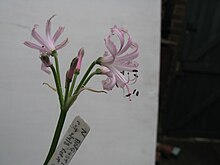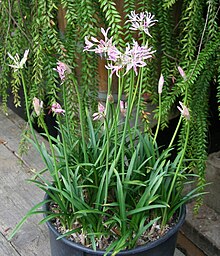Guernsey lilies
| Guernsey lilies | ||||||||||||
|---|---|---|---|---|---|---|---|---|---|---|---|---|

|
||||||||||||
| Systematics | ||||||||||||
|
||||||||||||
| Scientific name | ||||||||||||
| Nerine | ||||||||||||
| Herb. |
The Nerine or nerines ( Nerine ) are a plant kind from the family of the Amaryllis (Amaryllidaceae). The 22 to 30 species are common in southern Africa .
description






Appearance and leaves
Nerine species are perennial herbaceous plants . These geophytes form onions as persistent organs. There are evergreen species and species that only develop leaves in winter or summer. The basal and alternate leaves are sessile. The simple, parallel-veined leaf blade is linear or lanceolate. The leaf margin is smooth.
Inflorescences and flowers
Usually dold-like inflorescences are formed. There are usually two bracts . The hermaphroditic, threefold flowers are more or less zygomorphic . The six free bracts are shaped identically ( tepals , perigones ) and relatively narrow. The edge of the bracts is usually wavy. The color palette of the flowers ranges from scarlet and crimson to light pink and white, depending on the type .
ingredients
The Nerine species are poisonous and contain lycorin .
Systematics and distribution
The original distribution area of the genus Nerine is southern Africa. Many species are floral elements of the Capensis . The greatest biodiversity can be found in South Africa , especially in the summer rain area of the Eastern Cape Province . Several species are endemic to a very narrowly defined area . The species occur in all South African provinces as well as in Lesotho and Swaziland . A few more widespread species also grow in Namibia and Botswana .
The genus Nerine was established by William Herbert . The genus name Nerine is derived from the Greek sea nymphs , the Nereids . A synonym for Nerine Herb. is Imhofia Heist.
The genus Nerine belongs to the subtribe Strumariinae from the tribe Amaryllideae in the subfamily Amaryllidoideae within the family Amaryllidaceae . It used to be part of the Liliaceae family.
There are 22 to 26 (previously up to 30) species in the genus Nerine :
- Nerine angustifolia (Baker) W.Watson : It is common in Lesotho , Swaziland and the South African provinces of Eastern Cape , Free State , Gauteng , KwaZulu-Natal and Mpumalanga . It thrives in summer rain areas. In 2004 it was classified in the Red List of Endangered Species in South Africa as “least concern” = “not endangered”.
- Nerine appendiculata Baker : It occurs in the Eastern Cape and in KwaZulu-Natal. The stocks are considered stable. It is classified in the Red List of Endangered Species in South Africa as “least concern” = “not endangered”.
- Nerine bowdenii W. Watson : It occurs from the southern Drakensberg to King William's Town in the Eastern Cape and KwaZulu-Natal. It thrives on subalpine meadows and in the Drakensberg-Amathole afromontane fynbos in cool, moist depressions of rock faces and steep slopes with accumulations of deep humus soils. The nine known sites contain only a small number of specimens. Since the sites are inaccessible, the stocks are considered stable. It was rated “Rare” = “rare, but not endangered” in the Red List of Endangered Plant Species in South Africa. The species includes two subspecies.
- Nerine filamentosa W.F.Barker : It occurs in the Eastern Cape. The stocks are considered stable. It is classified in the Red List of Endangered Species in South Africa as “least concern” = “not endangered”.
- Nerine filifolia Baker (Syn .: Nerine filifolia var. Parviflora W.F.Barker , Nerine parviflora (WFBarker) grape ): It occurs in the Eastern Cape. The stocks are considered stable. It is classified in the Red List of Endangered Species in South Africa as “least concern” = “not endangered”.
- Nerine frithii L.Bolus : It occurs in the South African provinces of Free State, North Cape and North West . The stocks are considered stable. It is classified in the Red List of Endangered Species in South Africa as “least concern” = “not endangered”.
- Nerine gaberonensis Bremek. & Oberm. : It is distributed from southeastern Botswana to the northern South African provinces of Limpopo , North Cape and North West. It is classified in the Red List of Endangered Species in South Africa as “least concern” = “not endangered”.
- Nerine gibsonii K.H.Douglas : This endemic occurs only in Cala and Engcobo in the Eastern Cape. It thrives in high meadows between rocks. Only four sites are known. The habitats are degraded and overgrazed. Nevertheless, the stocks are considered stable. In 2011 it was classified in the Red List of Endangered Plant Species in South Africa as "vulnerable" = "endangered".
- Nerine gracilis R.A.Dyer : The top ten localities are distributed between Belfast and Ermelo to Wolmaransstad in the South African provinces of Free State , Mpumalanga and North West . It thrives in hilly grasslands in swampy areas. There are millions of specimens at a site in Mpumalanga where the grazing cattle have been removed. In the other locations, stocks are decreasing for various reasons. No specimens were found in Vaal Dam in 2002, but there are reports from there between 1977 and 1988. In 2013, it was classified as “vulnerable” in the Red List of Endangered Plant Species in South Africa.
- Nerine hesseoides L.Bolus : It occurs in the South African provinces of the North Cape, North West Free State . It is classified in the Red List of Endangered Species in South Africa as “least concern” = “not endangered”.
- Nerine humilis (Jacq.) Herb. : It occurs in the South African provinces of the Eastern and Western Cape. It is classified in the Red List of Endangered Species in South Africa as “least concern” = “not endangered”.
- Nerine huttoniae Schönland : It occurs only in the Great Fish River Floodplain area in the Eastern Cape. The stocks are at risk. It is classified in the Red List of Endangered Plant Species in South Africa as "vulnerable" = "endangered".
- Nerine krigei W.F.Barker : It occurs in the South African provinces of Gauteng and Mpumalanga . It is classified in the Red List of Endangered Species in South Africa as “least concern” = “not endangered”.
- Nerine laticoma (Ker Gawl.) T.Durand & Schinz : It is classified in the Red List of endangered species in South Africa as “least concern” = “not endangered”. It iswidespreadfrom southern Zimbabwe through Namibia and in large parts of South Africa.
- Nerine marincowitzii Snijman : It is only known from one site in Leeu-Gamka in the Western Cape. The stock is particularly affected by pasture farming. It is classified in the Red List of Endangered Plant Species in South Africa as "vulnerable" = "endangered".
- Nerine masoniorum L.Bolus : Only two sites were known near Umtata in the Eastern Cape Province, one of which was reported as destroyed in 2000. It is rated “Critically Endangered” in the Red List of Endangered Plant Species in South Africa.
- Nerine pancratioides Baker : There are probably 10 to 15 isolated sites only in KwaZulu-Natal. It is classified in the Red List of Endangered Plant Species in South Africa as "vulnerable" = "endangered".
- Nerine platypetala McNeil : There are fewer than ten sites from Wakkerstroom to Groenvlei on the border between the provinces of KwaZulu-Natal and Mpumalanga . It is classified in the Red List of Endangered Plant Species in South Africa as "vulnerable" = "endangered".
- Nerine pudica hook. f. : It occurs only at two localities in the Riviersonderend mountains in the Western Cape. It only blooms after bush fires and therefore there are only a few herbarium specimens. It was rated “Rare” = “rare, but not endangered” in the Red List of Endangered Plant Species in South Africa.
- Nerine pusilla Dinter : It occurs in eastern and central Namibia.
- Nerine rehmannii (Baker) L.Bolus : It is classified in the Red List of Endangered Species in South Africa as “least concern” = “not endangered”. It occurs in northern South Africa (Gauteng, Mpumalanga) and in Swaziland .
- Nerine ridleyi E. Phillips : It only thrives at higher altitudes from Koue Bokkeveld to the Hex River Mountains in the Western Cape. It was rated “Rare” = “rare, but not endangered” in the Red List of Endangered Plant Species in South Africa.
- Nerine sarniensis (L.) Herb. (Syn .: Nerine curvifolia (Jacq.) Herb. , Nerine fothergillii (Poir.) M.Roem. , Nerine venusta (Ker Gawl.) Herb. ): It occurs only in the Western Cape. It is classified in the Red List of Endangered Species in South Africa as “least concern” = “not endangered”. It is a neophyte in France, the Azores and Madeira.
- Nerine undulata (L.) Herb. (Syn .: Nerine alta W.F.Barker , Nerine flexuosa (Jacq.) Herb. ): It occurs only in the Eastern Cape. It is classified in the Red List of Endangered Species in South Africa as “least concern” = “not endangered”.
- Nerine × versicolor Herb. = Nerine sarniensis × Nerine undulata : It occurs in South Africa.
Use as an ornamental plant
Varieties of some species are used as ornamental plants in parks and gardens.
History of ornamental plants
The first evidence of a Guernsey lily, Nerine sarniensis , grown in Europe comes from Paris in 1630. For the Guernsey lily Nerine sarniensis , a species endemic to Table Mountain near Cape Town , Guernsey became a cultivation center. The most important species was named after this island: "Sarnia" was the name of the island in the time of the Roman Empire . At the beginning of the 19th century, the export of cut flowers by local plant breeders became an important industry in Guernsey. The Guernseylile was among the first species to be exported to London. But since only a part of the onions bloomed annually, the Guernsey lily soon lagged behind the gladiolus and other cut flowers.
swell
- Rachel & Rod Saunders: Nerines in South Africa: A Primer .
- Mark Hyde, Bart Wursten: Entry in the Flora of Zimbabwe , 2009.
- Graham Duncan, 2002: Nerine sarniensis at PlantZAfrica of the SANBI = South African National Biodiversity Institute .
Individual evidence
- ^ A b c Nerine in the Germplasm Resources Information Network (GRIN), USDA , ARS , National Genetic Resources Program. National Germplasm Resources Laboratory, Beltsville, Maryland. Retrieved October 17, 2014.
- ↑ a b c d e f g h i j k l m n o p Rafaël Govaerts (Ed.): Nerine. In: World Checklist of Selected Plant Families (WCSP) - The Board of Trustees of the Royal Botanic Gardens, Kew . Retrieved September 22, 2016.
- ↑ a b c d e f g h i j k l m n o p q r s t u v w x List of species for Nerine in the Red List of South African Plants . Retrieved October 17, 2014
- ↑ a b Werner Voigt, 2004: 'Nerine humilis' and botanical history of 'Nerine sarniensis' at PlantZAfrica of the SANBI = South African National Biodiversity Institute .
- ↑ Gordon Cheers (Ed.): Botanica. The ABC of plants. 10,000 species in text and images . Könemann Verlagsgesellschaft, 2003, ISBN 3-8331-1600-5 (therein pages 601-602).


